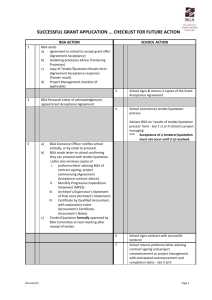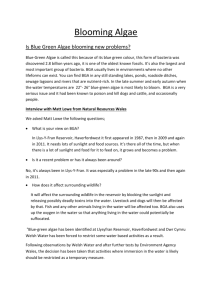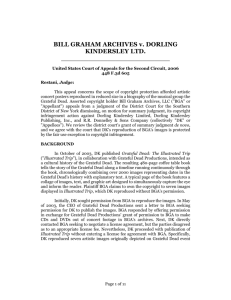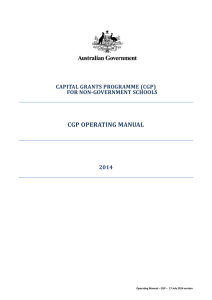BlueGreen Alliance: Sustainability & US Industry
advertisement
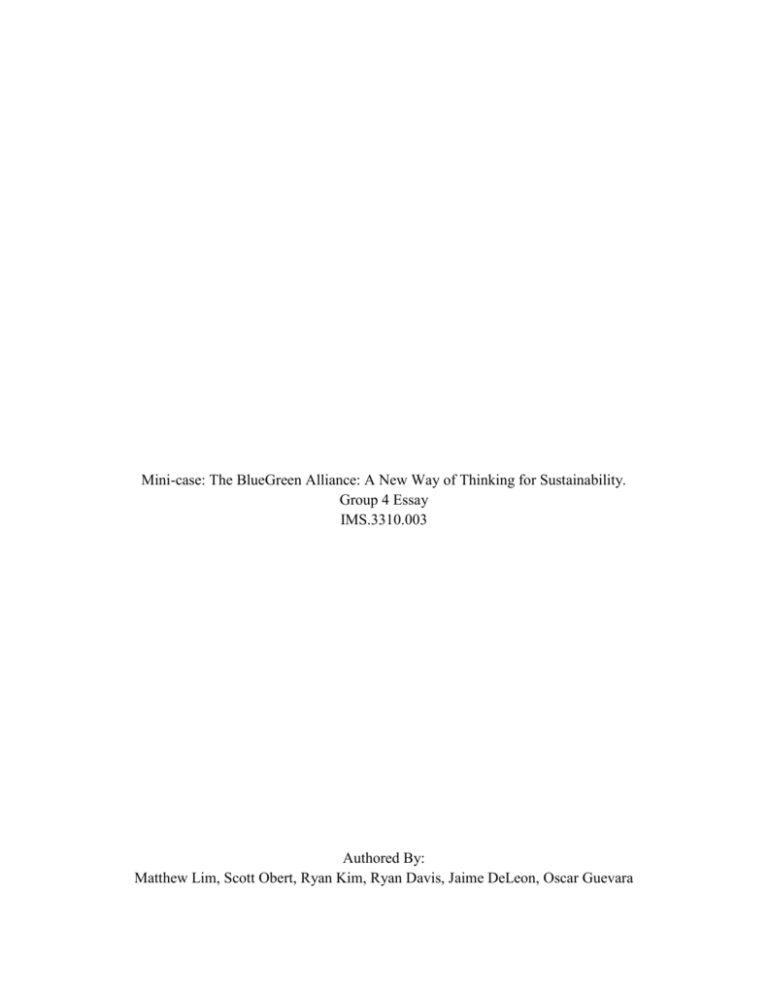
Mini-case: The BlueGreen Alliance: A New Way of Thinking for Sustainability. Group 4 Essay IMS.3310.003 Authored By: Matthew Lim, Scott Obert, Ryan Kim, Ryan Davis, Jaime DeLeon, Oscar Guevara The Blue Green Alliance (BGA) is an isolationist snub at the efforts of the global attempt in curbing the output of greenhouse gases that lead to global warming. While the BGA works to pair environmental agencies with American industry, it doesn’t actively engage in the global community. American protests in joining the organization came from the Bush administration claiming that the protocol didn’t provide enough ‘bang for the buck’. In 2007, the US produced approximately 25% of the planet’s greenhouse gases with respect to the rest of the industrialized world. But, “the problem is,” says U.S. Special Envoy Todd Stern, “Kyoto only covers 20% of the actual emissions because of its sole focus on the developed nations.” One of the initial members to the BGA, United Steel Workers (USW), partner to the Sierra Club, has been an advocate of many large environmental concerns and measures to curb the continued damage to the environment. USW’s commitment to environmental consciousness includes the successful advocacy for the amendments to the Clean air act in 1990 (initially passed in 1963) along with other policies that gave workers and people of the country the ‘right to know’ about the presence and use of toxic chemicals. In forming the BlueGreen Alliance, the USW partnered with the Sierra Club understanding the intersection of economic growth, environmental challenges and the damaging impacts of globalization. The duo shed light on a perception where American industries were sinking under the weight of a global economy. Their moral stance focused on a global economy where goods are easily imported from countries that don't subscribe to the same labor, environmental and human rights standards as the United States. The USW’s partner in the cause, the Sierra Club, has a great legacy in the forming of the Occupational Safety Health Administration (OSHA) to protect workers in their field of business. While they have always been advocates of worker safety and exposing the ills of toxic chemicals in the workplace, their impact has been largely domestic. Their primary concern always lies in the preservation of national parks and the lobbying for green policies such as efforts to prevent climate change. Despite their green initiative, the Sierra Club came into a bit of controversy in 2012 when they had accepted over $26 million in gifts from the natural gas industry, mostly from the CEO of Chesapeake Energy. Michael Brune learned of the gifts when he succeeded Carl Pope as executive director of the Sierra Club in 2010. Brune terminated the financial agreement with Chesapeake Energy but did not disclose the amount of the financial donations publicly at the time. The BGA has a continued presence in the leadership of individuals who are great advocates of their cause in American politics. In 2009, Executive Director of the BGA David Foster addressed the Senate Committee on Environment and Public Works on comprehensive legislation in pursuit of good jobs in pursuit of a greener economy. Fine points are made regarding legislation towards capping emissions and creating incentives for US businesses to create more of a clean energy economy, but you shouldn’t have to pass new legislation to inspect plant maintenance to see if the factories’ pipes are not leaking potentially toxic waste into the surrounding environment. In highlighting the benefits of passing a Renewable Energy Standard, the highlight again is the number of jobs created across the states. Along side projected job increases are anecdotal stories of people who are actually working to develop their business around green technology to include guided solar panels, turbines for wind energy and improved steel production for windmill hubs. The confound though arises though is what would prevent the US from joining the global community in the Kyoto Protocol whose mission serves the same ecological cause to benefit the US along with our ecosystem as a whole. The Kyoto Protocol is an international treaty extending the 1992 United Nations Framework on Climate Change (UNFCC). The agreement commits state parties to reduce greenhouse emissions by [5% based on 1990 standards] and has outlined specific greenhouse gases to be controlled in the first commitment period of 2008-2012. Climate Change Climate change is an important issue for BlueGreen Alliance (BGA). In addition to USW and Sierra Club, other BGA partners include Communications Workers of America, National Resources Defense Council, Laborers International Union of North America, and the Service Employees National Union. The creation of jobs and reduction of greenhouse gases is one of BGA’s most important issues that they are currently dealing with. BGA believes that global warming is evolving into an environmental and economic epidemic that must be dealt with immediately, both in U.S. legislation (reducing emissions) and by creating energy efficient jobs. A goal of BGA is the creation of millions of new and existing, green-energy jobs, particularly in manufacturing and construction. An example for potential construction jobs includes repairing and replacing natural gas distribution pipelines for cleaner fuel. This form of construction would create 313,000 jobs for American workers alone. Infrastructure is a big issue when it comes to BGA’s goal for producing cleaner fuel and energy. Broken down infrastructure systems include: natural gas distribution, water pipes, and the roads and bridges in our states. These failed systems create excess carbon pollution and other greenhouse gas emissions that contribute to climate change. They also cost the U.S. time and money. Repairing failing infrastructure systems like transit, energy and water could create 2.7 million jobs across the economy and increase the U.S. Gross Domestic Product (GDP) by $377 billion. Another area for job creation is manufacturing. You might ask yourself, how would green energy withstand the grueling demands to power the United States’ infrastructure today? BGA proposes we create installments in green energy systems. For example, wind energy from turbines, solar panels, geothermal and biomass projects are a great source of energy to help power the fundamental systems serving the U.S. BGA not only stops there; they have said that with energy efficient startups, broadband investments, and mass transportation systems; they all have the power to modernize the country’s manufacturing capabilities if certain policies are passed. In the past 18 months in the United States, over 1.2 million construction workers were laid off for various reasons, but if these manufacturing projects were to pass legislation, it could create millions of new jobs across the country. BGA’s other main issue is reducing emissions and greenhouse gases. Their main goal is to reduce U.S. emissions by at least 80 percent from 1990 levels by 2050. Other goals include reducing emission levels below 2005 emission levels by the year 2020. The Environmental Protection Agency (EPA) is creating new standards, which will decrease carbon emissions in the United States. These new regulations by the EPA are known as the “Clean Power Plan”. Its purpose is to reduce carbon emissions from power plants while also expanding renewable energy and energy efficiency efforts that create jobs across the country. The Clean Power Plan draft “establishes state-by-state carbon emissions rate reduction targets, and offers flexible framework under which states may meet those targets. It would reduce electricity sector emissions by an estimated 30 percent below 2005 levels by 2030” (Google Clean Power Plan). The “Zero Emission Vehicle Action Plan” is another way in which BGA plans to reduce U.S. emissions. The plan insists on getting 3.3 million plug-in electric vehicles on the road by 2025. By creating a strong market in the Zero Emission Vehicle Action Plan, it will require the creation of recharging stations nationwide for the growing number of electric cars (another avenue for job creation). This plan will have a massive impact on helping to reduce motor vehicle pollution across the country, and shift the U.S. into an era of clean energy solutions. Trade Policies In 2006, the newly established partnership of steel and coal union workers joined hands with environmentalists to campaign a set of policies that focused on trade and environmental policies. Under its initiatives, BGA advocates for the adoption of fair trade policies to leverage job growth for the middle-class workers, while moving America towards the consumption of home-grown clean energy. BGA maintains that U.S. manufacturing has been neglected for the last 60 years as the country focused its attention on globalization and the financial sectors. With the end of WWII, the International Monetary Fund (IMF) formed in 1945 to restore the world’s financial payment system. As world trade ballooned with the inception of “trade not aid”, the U.S. steadily let go of its competitive advantage. Beyond the criticisms of historical events, the Trade Promotion Authority (Fast Track) is at the heart of today’s BGA’s censure. This policy gives the president the power to create trade agreements without congressional involvement. The alliance believes past and current “trade agreements made the economies of scale of the U.S. market available to overseas producers while the U.S. obtained no reciprocal market access.” (Foster) Unfair trade policies have deep and lingering impacts according to BGA. An open trade system gives developing countries an opportunity to obtain the levels of technology and cost-effective production many developed countries already have. As oversea competition grows, the strength of the U.S. economy is more and more dependent on its competitors. Domestic goods become less attractive as foreign competition is now able to supply more affordable goods to consumers. Thus, incentives for domestic growth diminishes, infant industries crumble and investors redirect their capital and operations overseas. In response, BGA has developed programs like “Buy America” and others to revitalize domestic production and jobs. Its second objective targets climate-change legislation. The alliance has proposed policies that address the unchecked environmental issues. Even current regulations like the American Clean Energy and Security act are not comprehensive enough to prevent the irreversible impacts of climate change. BGA is focused on setting new renewable energy standards, further restricting cap-and-trade levels, and attaching long-term border adjustment provisions to prevent “carbon leakage”. Perhaps the most fundamental objective for BGA is job creation. BGA claims “more than 56,000 U.S. factories have closed or moved overseas.” In a study conducted by the BGA, their “base case” projections revealed that only 11,000 jobs would be created within the waste management sector by 2030. But under its “Green Economy Scenario”, BGA could generate an astonishing 1.7M jobs within the same 15 year projection. While the intentions appear respectable and advocate for proactive efforts, there is something to say about the new partnership. The formation of hardened union workers and environmentalist is curious and unusual. It warrants one to explore what is beyond the surface to find some possible explanations and motives. Even today, a stagnant thinking is among the old and neo-mercantilists. Exports are favored as it presumably creates jobs, while imports are heavily detested. However, union membership in the last quarter century has steadily declined from its peak at 36 percent to its current 8 percent rate. Perhaps a brilliant move or mere coincidence, labor unions began rallying alongside environmentalists in 2008 in an effort to change legislation. Initial victory came after an amendment to the Lacey Act, which now requires importers to identify the source of wood products. Seemingly benign, many argue these type of adoptions are deliberate strategies which are disguised protectionism. The goal is to create a complex maze of nontariff barriers designed to further complicate the already existing tariff restrictions. The ulterior motive is strategically designed to slow and even discourage imports to force domestic firms to source within the borders. Does BGA’s policies really benefit the domestic greater good? In order for the policies to be effective, greater trade restrictions are necessary to reach sustainability. Oddly enough, many believe that restricting imports translates into a higher demand for domestic labor. This mentality undercuts the ideas of free trade. Unfortunately, coercion is at play and politicians are a key component to the BGA’s agenda. The effects are both real and subtle in terms of costs. The net benefits to BGA are heavily outweighed by the costs to the rest of the U.S. In order to kick off BGA’s programs, it requires over $150B in government subsidies in addition to the perpetuities needed to sustain the programs. Hidden among the language, unions demand mandates that set wages well above the market averages as well as the assurance of those wages through long-term union contracts. Interestingly enough, while union membership has declined, U.S. manufacturing has steadily received the highest portion of FDI inflows. What role do environmentalists have in BGA? Most environmental activists lack the key ingredient, which is funding. Under its “saving the planet” umbrella, environmentalist and unions have overlapping interests. Environmentalists turn their attention to the industries which emit high pollutants and consume large natural resources. They too, advocate tighter import restrictions, but in the form of banning importation of wood or minerals illegally logged or mined. As a substitute, energy must be created through the alternative forms, mainly by way of wind and solar infrastructure. Inevitably, its union partners will be tasked with manufacturing the infrastructure. The growth of globalization is largely made possible by the phenomenon of free trade. Historically, a country’s openness to trade leads to greater gains and FDI. The chart below illustrates how the two elements lead to benefits. There is also an interesting connection between a country’s environmental standards and FDI. The graph below illustrates that a higher environmental standard index (ESI) leads to higher FDI. Can BGA’s policies offer a new approach to sustainability? It’s important to understand the composition of the alliance, and only after this will the ulterior motives become redundant. Historically, unions are centric thinkers who focus on bettering and protecting their members. The stagnant beliefs persist, but now its protectionist views are merely being disguised under their new title; environmentalism. From an economic view, the fair trade theory focuses on the relative gains, not the absolute ones. No matter what trade theory the U.S. adopts, the economic mechanisms are still at work. Consumer preferences and choices change as the cost of goods increase. Works Cited: Testimony of David Foster. Executive Director, BlueGreen Alliance. “David Foster Advocates Comprehensive Legislation Before Senate Committee.” Bluegreenalliance.org. Oct. 2009. <http://www.bluegreenalliance.org/news/publications/testimonyofdavidfosterussenatecommittee onenvironmentandpublicworks> Lombardozzi, Brain, “Buy America: One Element of the Solution to our Job Crisis.” Bluegreenalliance.org. Aug. 2011. < http://www.bluegreenalliance.org/blog/buyamericaoneelementofthesolutiontoourjobcrisis> Maskus, Keith. Rising Protectionism and U.S. International Trade Policy. Economic Review, Federal Reverse Bank of Kansas City. July 1984. "BlueGreen Alliance / Blue-Green Blog / Republicans Divided on Climate Change Agenda." BlueGreen Alliance. BlueGreen Alliance, 15 Jan. 2015. Web. 08 Mar. 2015. "BlueGreen Alliance / Latest News / State of the Union: Respond to Climate Change, Invest in Clean Economy." BlueGreen Alliance. BlueGreen Alliance, 12 Feb. 2013. Web. 08 Mar. 2015. "BlueGreen Alliance / Blue-Green Blog / Blog Archive." BlueGreen Alliance. BlueGreen Alliance, n.d. Web. 08 Mar. 2015. BlueGreen Alliance / Blue-Green Blog / Blog Archive. “U.S. to Seek WTO Settlement of Chinese Wind Energy Subsidy Dispute. Dec. 2010. <http://www.bluegreenalliance.org/blog/archive?month=december-2010>


